

The increase of independence is also observed in this transition stage.
Most parents would agree that handling teenagers is a tough challenge for them but here are some resources for parents to help them understand how operant conditioning can influence and change the behaviour of their teenagers.
Understanding Teenagers. Article: What Teens Need Most From Their Parents. The teenage years can be mystifying for parents.

Sensible children turn scatter-brained or start having wild mood swings. Formerly level-headed adolescents ride in cars with dangerous drivers or take other foolish risks. A flood of new research offers explanations for some of these mysteries. Brain imaging adds another kind of data that can help test hypotheses and corroborate teens’ own accounts of their behavior and emotions. Dozens of recent multiyear studies have traced adolescent development through time, rather than comparing sets of adolescents at a single point. Short read: How to discipline teenagers. Article: Teen Bad Behavior & Discipline Plans - Promoting Healthy Growth Ages 15 - 18.
Bad behavior doesn't end when your child graduates from diapers -- or even from middle school.

In fact, the teen years can bring some of the toughest discipline challenges parents have to face. Sulking, arguing, lying, and rebelling are just a few of the ways teens misbehave. There's a good explanation for these bad behaviors. As teens become more independent, they still lack the emotional maturity they need to make informed, thoughtful decisions. Understanding operant conditioning. Video: What is Operant Conditioning? Article: The Four Types Of Operant Conditioning. Necessary cookies help make a website usable by enabling basic functions like page navigation and access to secure areas of the website.
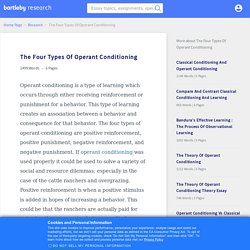
The website cannot function properly without these cookies. Preference cookies enable a website to remember information that changes the way the website behaves or looks, like your preferred language or the region that you are in. Article: Reinforcement and Punishment. Learning Objectives Explain the difference between reinforcement and punishment (including positive and negative reinforcement and positive and negative punishment)Define shapingDifferentiate between primary and secondary reinforcers In discussing operant conditioning, we use several everyday words—positive, negative, reinforcement, and punishment—in a specialized manner.
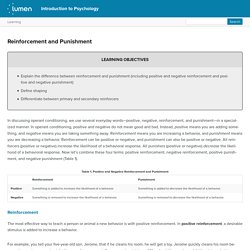
Understanding punishment. Video: Positive and negative punishment. Guidelines for using punishment. Examples of positive punishment and how to apply it. Article: Positive Punishment: What It Is, Benefits, and Examples. Positive punishment is a form of behavior modification.
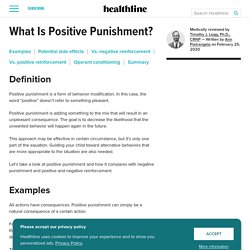
In this case, the word “positive” doesn’t refer to something pleasant. Positive punishment is adding something to the mix that will result in an unpleasant consequence. Examples of negative punishment and how to apply it. Article: Negative Punishment Examples. Nobody ever wants their stuff taken away.
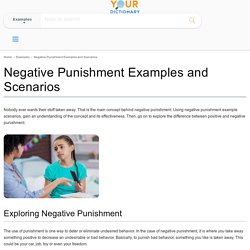
That is the main concept behind negative punishment. Using negative punishment example scenarios, gain an understanding of the concept and its effectiveness. Then, go on to explore the difference between positive and negative punishment. Exploring Negative Punishment. Positive punishment vs Negative punishment. Understanding reinforcement. Article: Positive vs. Negative Reinforcement: A Guide for Parents. I almost stopped bringing them to the playground.
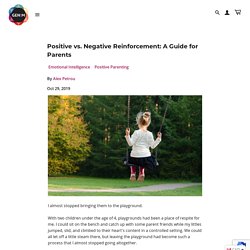
With two children under the age of 4, playgrounds had been a place of respite for me. I could sit on the bench and catch up with some parent friends while my littles jumped, slid, and climbed to their heart's content in a controlled setting. We could all let off a little steam there, but leaving the playground had become such a process that I almost stopped going altogether. Inevitably, when I announced it was time to go, my 3-year-old would run away. Video: Positive Reinforcement. Guidelines of using reinforcement to influence behaviour.
Example of positive reinforcement and how to apply. Article: Use Positive Reinforcement to Help Change Behavior. In households where a child is using substances, it can be easy to focus on everything the child is doing wrong and respond with lectures, punishment and confrontation.

Unfortunately, this often only escalates the tension. So what can you do? Examples of negative reinforcement and how to apply. Article: Examples of Negative Reinforcement. It helps to explore some examples of negative reinforcement, a concept of operant conditioning that people frequently misunderstand.

Learn what negative reinforcement is and see how it works in practice. What Negative Reinforcement Is and Is Not. Article: Negative reinforcement. Negative reinforcement encourages specific behaviors by removing or avoiding negative consequences or stimuli.
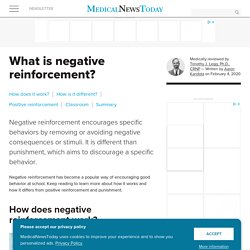
It is different than punishment, which aims to discourage a specific behavior. Negative reinforcement has become a popular way of encouraging good behavior at school. Keep reading to learn more about how it works and how it differs from positive reinforcement and punishment. Positive reinforcement vs Negative reinforcement. Article: Teacher to Parent - Positive reinforcement doesn't work in the long run. Q. My third grade son recently came home in tears saying he didn’t want to go to school anymore because he was punished for talking during silent reading. The teacher kept him in from recess. I think this is horrible. It isn’t a teacher’s job to destroy a child’s love for school. Instead of constant punishment for every little infraction, what about using positive reinforcement?
Punishment or Reinforcement? Which is better to influence the behaviour of your teen? Article: Rewarding behavior is key to parenting teens, study suggests. Parenting is hard, and parenting teens brings about an entirely new set of challenges, from keeping their rooms clean to getting them home before curfew. But, a new study suggests parents who want their teenagers to keep their grades up could have better success if they focus more on rewarding good behavior and less on threatening to punish the bad. According to the report, published in PLOS Computational Biology, British researchers have found that adolescents focus well on positive incentives, but have difficulty staying motivated to avoid penalties. The study shows that teens and adults learn in different ways, according to the study’s lead author Stefano Palminteri, a researcher with the Institute of Cognitive Neuroscience at University College London.
It suggests that “in some cases positive feedback may have more of an effect than negative feedback on learning” in adolescents. “Rewards give them something they want to think about,” Allen said. Article: Adolescent learning: rewards, punishments, and the importance of context. Adolescents’ unique sensitivity to rewards is thought to be due to increased activity in and communication between areas of the brain that respond to rewards. However, we also know that many of the same brain areas also respond to punishment and that there are dynamic changes occurring throughout the brain during adolescence. Much like the complexity of brain development, the story about how adolescents learn from reinforcement might not be so simple.
“The way that adolescents learn from the choices that they have made in the past will ultimately influence their future choices and actions.”